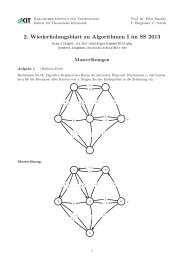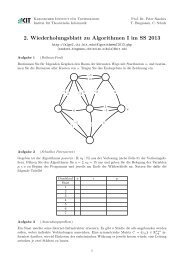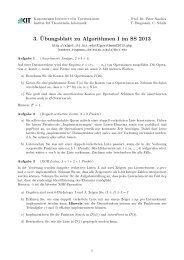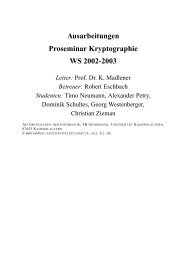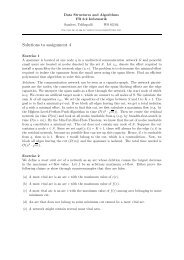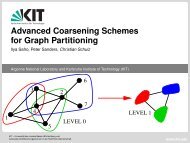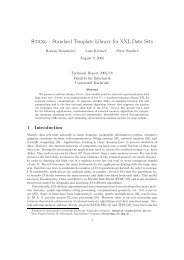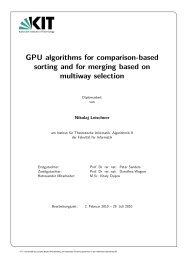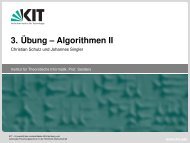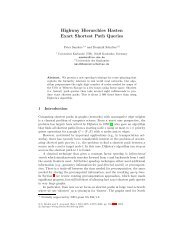LNCS 3142 - The Power of Verification for One-Parameter Agents
LNCS 3142 - The Power of Verification for One-Parameter Agents
LNCS 3142 - The Power of Verification for One-Parameter Agents
You also want an ePaper? Increase the reach of your titles
YUMPU automatically turns print PDFs into web optimized ePapers that Google loves.
180 V. Auletta et al.<br />
machine i by X1 with respect to the real weights <strong>of</strong> the jobs. We have now to<br />
complete X1 by allocating the small jobs J S = {J1,J2,...,Jk) not considered<br />
in the previous phase. We assign job Ji to the machine that minimizes its completion<br />
time with respect to the work assigned to it by X1 and by the allocation<br />
<strong>of</strong> the small jobs J1,...Ji−1. If there are more machines that obtain the same<br />
completion time we select the slowest one. If the schedule obtained at the end<br />
<strong>of</strong> this phase has cost greater than C(1 + ɛ) (with respect to the real weights<br />
<strong>of</strong> the jobs) then oracleɛ returns fail. Otherwise, oracleɛ continues with the<br />
adjustment phase.<br />
Phase III: Adjustment. In the final adjustment phase the algorithm partitions<br />
the machine into two sets: slow machines and fast machines. <strong>The</strong> aim <strong>of</strong> this<br />
phase is to en<strong>for</strong>ce that each fast machine will receive positive load. <strong>The</strong> partition<br />
is computed in the following way. We assume without loss <strong>of</strong> generality that the<br />
number <strong>of</strong> jobs is larger than the number <strong>of</strong> machines and stress that jobs are<br />
ordered by nondecreasing weight and machines are ordered by nondecreasing<br />
speed. <strong>The</strong> first m jobs are assigned each to one machine with machine i getting<br />
the Ji. Suppose that the makespan <strong>of</strong> the one-to-one scheduling obtained is<br />
greater than C(1 + ɛ). <strong>The</strong>n, it is easy to observe that, all schedules that assign<br />
positive load to all machine have cost greater than C(1 + ɛ). Thus we repeat the<br />
same procedure by considering the m−1 fastest machines and the first m−1 jobs.<br />
<strong>The</strong> procedure stops when we find a one-to-one scheduling <strong>of</strong> jobs J1,...,Jm−d<br />
to the machines <strong>of</strong> speed sd+1,...,sm <strong>of</strong> cost not greater than C(1 + ɛ). <strong>The</strong> set<br />
<strong>of</strong> slow machines will then be the set <strong>of</strong> the first d machines and the remaining<br />
machines constitute the set <strong>of</strong> fast machines. By the discussion above, it is easy<br />
to see that any scheduling that assigns positive load to more than m−d machines<br />
has cost greater than C(1 + ɛ). More precisely, by denoting with discard(u, J, s)<br />
the number d <strong>of</strong> slow machines <strong>for</strong> an instance (J, s) and bound u we have the<br />
following lemma.<br />
Lemma 2. Let X ∈ sol(J, s) be a schedule that assigns positive load to more<br />
than m − discard(u, J, s) machines. <strong>The</strong>n m(X, (J, s)) >u.<br />
<strong>The</strong> adjustment phase then continues in the following way. Let X2 be the schedule<br />
computed at the end <strong>of</strong> Phase II and remove jobs J1,...,Jm−d from X2 .<br />
For each i =1,...,m− d, let ℓi be the machine to which X2 assigns job Ji. If<br />
machine (d + i) has no load then Ji is assigned to this machine; otherwise Ji is<br />
re-assigned to machine ℓi. <strong>The</strong> schedule X3 obtained at the end <strong>of</strong> this phase is<br />
then given in output by oracleɛ.<br />
Lemma 3. If oracleɛ(C, J, s) = fail then the schedule output by oracleɛ assigns<br />
positive loads exactly to the m − discard(C, J, s) fastest machines.<br />
<strong>The</strong> next theorem proves that either oracleɛ gives a schedule <strong>of</strong> cost at most<br />
C(1 + ɛ) or no schedule <strong>of</strong> cost less than C exists.<br />
<strong>The</strong>orem 4. If oracleɛ(C, J, s) =fail, then opt(J, s) ≥ C.<br />
If, instead, oracleɛ(C, J, s) returns a schedule X then m(X, (J, s)) ≤ C(1 + ɛ).<br />
Next theorem proves that oracleɛ is stable.



